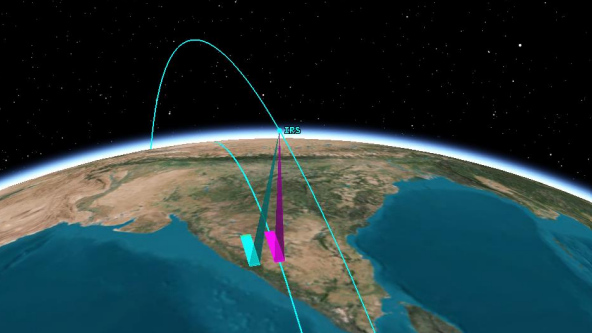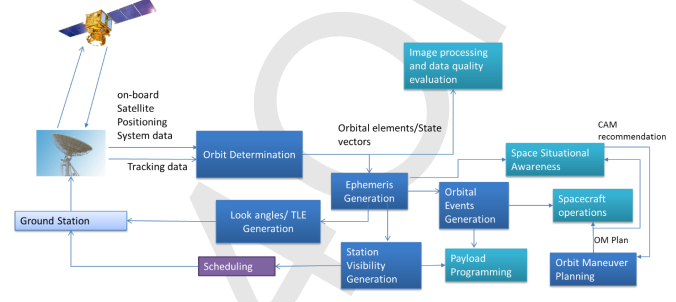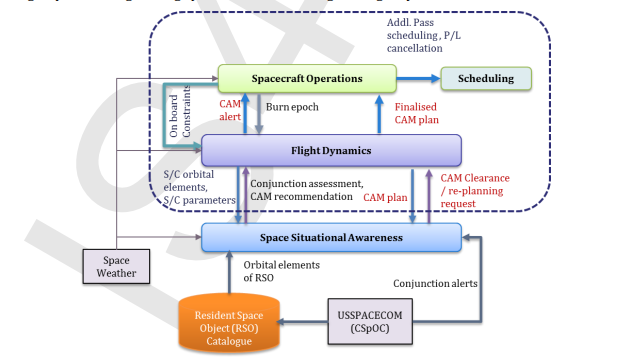Consequent to the completion Flight Dynamics of the launch and early orbit phase ending in 3-axis stabilization with reaction wheels and magnetic torquers, the performance of Attitude and Control (AOC), Power, Satellite Positioning System (SPS), Sensors, Telemetry, Tele-Command and Thermal systems are reviewed. If the performances of all subsystems are nominal, the commissioning of the payload is carried out in phases. The time duration of the payload systems commissioning depends on the type
of payload with precautions taken to ensure degaussing of the detectors if necessary, deployment of the antenna, door opening for the imager, operating high voltage circuits in steps etc. Payload and Sequencer pre-selections are carried out and the downlink carrier for the payload is turned ON to characterize the RF parameters of the payload signal.
For Optical payloads, radiometric calibrations are carried out by using onboard calibrated LEDs which produce known intensities, imaging of the Moon and known areas with ground control points. For high-resolution optical payloads, the Point Spread Function (impulse response of payload detectors) and Modulation Transfer Functions (frequency response of payload detectors) are determined by pointing the payload and imaging the stars (Stellar Imaging) and earmarked regions on Earth.
For Synthetic Aperture Radar (SAR) payloads similarly, vicarious calibration operations are carried out with reference sites and different modes of operations. Though the first operation for optical and SAR payload is carried out within a few days after the launch, the payload operations for the science application (for example, Astronomy) take 1 or 2 months due to the nature of the instruments used with high voltage and highly sensitive packages.
Once the payload systems are commissioned and tested, they will be operated on a day-to-day basis as per the normal phase operation guidelines. The demands of multiple users have to finally culminate into command sequences that are to be uplinked to the satellite for payload operations daily. The complete Payload Programming System is automated and the advantage is that it enables error-free repeated operations, flexibility in terms of defining constraints, common rules and priorities for different users, maintains the timeline of activity, e-ordering, and ease of dissemination of products to customers.
While the routine payload operations planned and programmed well in advance, adequate flexibility is built in the ground segment chain to carry out emergency payload operations (for example disaster management) to be executed within a few hours of the request reception and data delivered to the user.
How many satellite does Saturn have ?#space #spacenews #technology #key2space #k2s #spacetech #x #saturn #saturnmoons #spaceballs pic.twitter.com/8ST4k3FG8g
— Key 2 Space (@keytwospace) January 23, 2024
Special Operations
The special operations generally demand configuration changes on-board for various needs. The requirements can be for calibration of the payload instrument in a specific mode, spacecraft orbit and attitude change to cater for the payload requirement, orbit manoeuvre for collision avoidance, drift correction for the on-board timer, calibration of the attitude sensors (for example, Gyro calibration). These operations are carried out in campaign mode with close coordination with all entities involved.
Anomaly Identification and Recovery
- Anomaly is an abnormal behaviour of any subsystem or any part of a sub-system:
- Any change which is not expected
- No change where change is expected Any parameter value beyond the set limits
Anomalies are categorized as
- Degradation
- Hang-up
- Partial sub-system failure
Sometimes an anomaly may cause no major impact and recovery is achieved by a system restart. In case of partial failure, system re-configuration is required. However, an anomaly, if left unattended, may lead to a contingency. A contingency disrupts normal operations and needs immediate intervention for recovery.
Interplanetary Operations
Interplanetary mission operations present an array of challenges that are generally not very often encountered in low-Earth (LEO) or geostationary (GEO) mission operations. The vast distances between celestial bodies demand precise navigation and communication, often involving signal delays that can range from minutes to hours. Due to the large signal delays, it is not possible to micromanage the interplanetary mission as any response from ground controllers through real-time commanding would possibly reach the satellite much later than the occurrence of an onboard event.
So, these types of missions are built with a lot of onboard autonomy to ensure that the spacecraft does not fully depend on the ground commanding in case of both nominal and contingency operations. Autonomy is built through both the hardware and software. Apart from onboard autonomy, these missions require spacecraft to endure extreme conditions, from the extreme heat to the bitter cold of deep space. Ensuring the reliability of complex systems for propulsion, power generation, and scientific instrumentation over extended durations is paramount.

Furthermore, planning and executing manoeuvres to insert, orbit, or land on another planet or moon require intricate calculations and impeccable timing. The dynamic nature of space environments, including radiation and micrometeoroids, adds additional complexity to mission planning and spacecraft protection. Finally, the constant evolution of technology and the need for real-time decision-making in response to unforeseen challenges underscore the perpetual nature of interplanetary mission operations. Overcoming these obstacles demands collaboration between scientists, engineers, and mission controllers. ISRO has vast experience in managing missions like the Mars Orbiter Mission, Chandrayaan-1, Chandrayaan-2, and more recently the landing of Chandrayaan-3 on the Moon.
Flight Dynamics Operations
Flight Dynamics (FD) operations of operational satellites primarily involve spacecraft orbit estimation and maintenance. Orbit manoeuvres are planned periodically as and when the Ground- Track or Local Time approaches the mission-specified limits, by conducting ‘In-plane’ or ‘Out of plane’ orbit maneuvers for LEO satellites. For GEO satellites, station-keeping manoeuvres (EW and NS) are conducted periodically. Apart from orbit maintenance, collision avoidance manoeuvres are planned to avoid collision with space debris as per input from the SSA operations team. These manoeuvres are given the highest priority to safeguard the spacecraft and are often planned on short notice
Day-to-day operational activities for satellite Flight Dynamics Operations include:
- Tracking data (primarily range and Doppler) pre-processing
- Orbit determination using tracking data and/or on-board GPS/NavIC measurements¹ acquired from spacecraft
- Generation of ephemerides, satellite orbital events (such as visibility, timings of eclipse, apsidal crossings, nodal crossings etc.), look angles and ground trace information to aid mission planning and operations. This also includes necessary inputs for real-time FD displays for the S/C operations team.
- Visibility generation over an extended time duration for advance planning
Low earth orbit satellites are usually equipped with GPS (Global Positioning System)/NavIC (Navigation with Indian Constellation) based receivers which act as the prime source for orbit information, tracking data-based orbit determination is used as backup. Dissemination of all FD products to various entities Basic Operational flow for flight dynamics operations.
Scheduling Operations
Scheduling accounts for the multi-mission support requirements and schedules the TTC network support and spacecraft operations for missions based on pre-defined scheduling guidelines. It is taken care that the visibility gap between consecutive passes is not more than 3 to 4 orbits. Following operations are planned by Scheduling.
- Telemetry reception from all Indian and foreign stations for all passes having more than 2 degrees maximum elevation
- Playback data collection
- Telecommand operation for passes with minimum elevation above 5 degrees
- Ranging data collection as per requirement for passes with max elevation above 8 deg.
- All types of playback data collection will be scheduled as per mission guidelines
- Payload calibrations scheduled as per normal phase mission operations guidelines
- Orbit Manoeuvre For LEO satellites, ground track and local time maintenance requirements are scheduled as per mission guidelines For GEO satellites, the East-West station keeping to arrest longitudinal drift and maintain continuous coverage, and North South station keeping for inclination control.
Supporting Elements

Ground station supporting TTC (telemetry and telecommand) TTC station support is based on the requirements emerging out of the mission requirements A typical TTC Station Configuration is shown in Figure 2-6. There are two chains depicted. Both work in real-time mode. One is the uplink chain and the other is the downlink chain. In the uplink chain, telecommands are routed through the systems before it is uplinked through the antenna to the satellite. In the downlink chain, data is received by the antenna and is routed through various systems before it can be processed and provided to the operations team.
Spacecraft control scenarios require computer terminals for executing different spacecraft control- related software. Spacecraft controllers use computer terminals to monitor Spacecraft Health in real- time and to command the satellite. Spacecraft analysts use computer terminals to carry out analysis of spacecraft performance over different periods of time.
Features of mission computer network for spacecraft operations are
- Capability to process the data in real time
- Sufficient disk storage capacity to store the data for entire mission life
- High availability and High performance
- Data network, processing, storage and security services in multi mission environment
- Distributed computer architecture in client server configuration
- Work stations for processing and display of spacecraft health data
- File servers/Data base servers for data management
- TCP/IP based WAN, LAN network with hot-redundant Switches and Routers.
- File transfer system and UTM-Firewall based secured data transfer with external agencies
Communication Network
CN provides real time voice/data/fax connectivity for TTC operation between Spacecraft Control Center (SCC) and other Network Stations both in India and abroad, supporting Launch Vehicle & Satellite during its launch / early orbit and normal phase of missions.
Requirements
- Real time TM data transmission from stations to SCC.
- Transmission of tracking data.
- Transmission of commands from SCC to stations
- Voice communication
- Voice/data/fax connectivity for TTC operations
- Connectivity through dedicated links between Control Center and all TTC stations
- Connectivity through dedicated links between Launch Control Center and TTC stations
Control Centre Facilities
All phases of mission are supported from Mission Control Facilities which include the following
- Mission Control Room
- Mission Analysis Room
- Dedicated Mission Control Room
- Timing Displays
- Projection and Wall Mounted Displays
- Audio and Video Systems
- Intercoms and Headsets
- Lecture and Conference Halls
- Video Conferencing Rooms
- Visitor Gallery
- Mission Documentation Room
Safe and Sustainable Operations Management
It is of paramount importance that space operations are conducted in a safe and sustainable manner. Operational spacecraft are vulnerable to various environmental threats that arise due to background radiation, energetic particles, other space objects (of natural and anthropogenic origin) etc. Hence being aware of such threats is essential through space situational awareness, which becomes an integral part of safeguarding spacecraft and ensuring its longevity.

Safety of spaceflight calls for close approach analysis of all resident space objects to detect collision threats well in advance so that remedial actions for collision avoidance can be initiated in time. Orbital knowledge of a threat object is an essential prerequisite of collision threat mitigation. For Earth-orbiting objects, this information is usually obtained from the Space-Track website of USSPACECOM (US Space Command) and also through special coordination for active satellites.
To address the sustainability of space operations, the mission orbits are selected in regions with relatively lower background flux through necessary analysis, so that the cumulative probability of on-orbit collision is minimised. Special care is taken while designing the spacecraft to minimise the risks of on-orbit break-up during mission operations and avoid any failure mode that may lead to the end of the mission.
At the end of life, spacecraft are decommissioned after re-orbiting/de-orbiting to
limit their presence in the LEO and GEO-protected orbital regions hosting operational space assets and passivation to minimise the risks of any post-mission explosions, as per internationally accepted guidelines.
Conclusion
Spacecraft operations are one of the key activities to ensure that the space-based services by the operational spacecraft are rendered regularly and uninterruptedly to the users. The crux of spacecraft operation lies in continual monitoring of spacecraft health, flawless execution of commands to configure on-board subsystems including payloads to achieve the mission goals, timely detection of anomalies and initiation of corrective actions, maintenance of its orbit and other parameters within the mission specified limits.
The various activities are adequately supported by various reviewing and reporting mechanisms. Apart from meticulous planning, synergy with different supporting entities is essential to achieve such highly complex and multidisciplinary activities.

